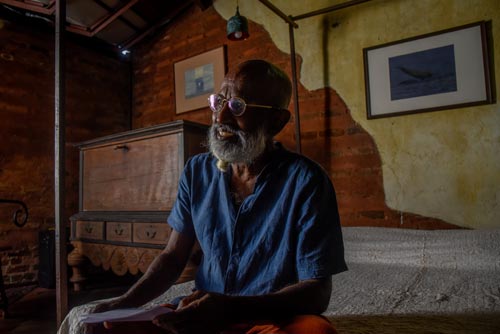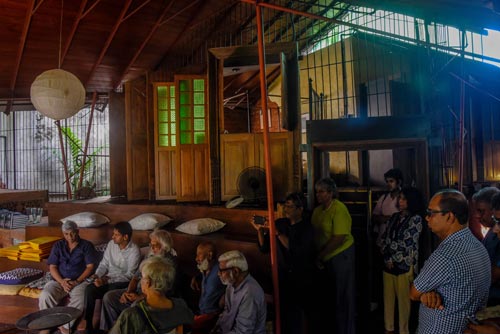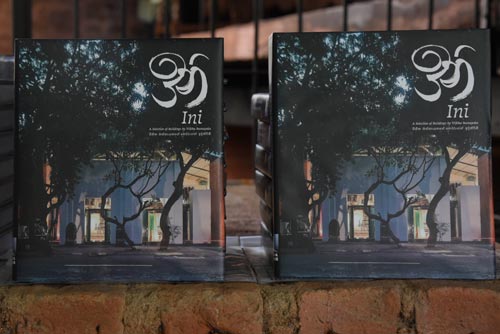Simplicity of a truly local look

Three decades of experience: Vijitha Basnayake speaking at the launch of his book. Pix by Akila Jayawardena
For Vijitha Basnayaka it all began with a father with wanderlust who used to take the family off the beaten track to places like Somawathi for holidays. The young Vijitha was deeply impressed by the ancient buildings rising from the jungle tide that had conquered them.
The now veteran architect, who this year celebrates 35 years married to his biro, saw the launch last week of Ini, a compendium of his work – a coffee table book with enviably atmospheric photography and crisp, evocative text.
Produced in both Sinhala and English, the book’s launch was at the Maulie de Saram house in Pelawatte, completed by Vijitha in 1993 where on 16 perches a variety of settings have been achieved through the old Japanese trick of screens, doors and windows. Yet, there is a local feel, bristling with foliage in dark shade.
Vjitha, born at Bollatha, Ganemulla in 1952, is an alumnus of the Moratuwa University where he learnt under the likes of Anura Ratnavibhushana, Ashley de Vos, and Chris de Saram, imbibing the ‘Modern Movement’, against which he would mutiny later.
The book itself is an act of rebellion, having Sinhala text – moving away from the idea of the ‘rich house and hotel’ being the sole domains where an architect rolls up his white sleeves.

Keeping it simple and modern: The Maulie de Saram house in Pelawatte
Why the enigmatic title ‘Ini’? Explains a blurb: “Ini, in Sinhala, refers to poles of various kinds such as bamboo shafts and rods, galvanised iron tubes, coconut batons and twigs…..used in everyday construction to support – and ‘scaffold’– the building production process. Even though these…….disappear as the building reaches its completion, their function, intervention and usage determine the nature, behaviour and performance of the final product.
“A building process evolves, drifts and nurtures through various intellectual meditations, cultural circumstances and social interventions.”
Few are the ‘selected works’ in the book (given Vijitha has done at least two buildings a year in a career of three decades and a half), but they encapsulate the spirit of his practice – closeness to nature paramount; and frugality (though not exactly proverbial Zen simplicity).

Unique coffee table Book: Atmospheric photography and crisp, evocative text in both Sinhala and English
In the Maulie de Saram house built in the 1980s and ’90s, railway sleepers for the floors were bought at 50 rupees each and half the walls were not plastered, the peeping brickwork creating the feel of an uncompleted Italian villa.
Such decisions in that era of middle class conventionality were bold and made Vijitha a trailblazer. However, it was all in aid of saving expenses in a shoestring budget and not “for mere style”.
He is adamant that trying to “polish things too much” causes problems. He tries his best to adhere to bare nature.
This, the book purports, is the essence of Lankan architecture: everything inspired by the practical and simple and never decorative in its own – like wooden ambalamas in the countryside and the magical Kaludiya Pokuna in Mihintale.
The book is a delectable cross section of houses, resorts, stores and even a desiccated coconut mill, all capturing the different guises of Vijitha’s muse, with those early forays enhancing his inspiration……whether in building his own small workspace, light saffron amidst the jungle in Bollatha or the Galkadawala Forest Lodge which looks like a ruined half-camouflaged manor from Kipling’s Jungle Book but with all comforts.
 While the post-Bawa architecture cannot escape the master’s influence, Vijitha has made his own mark distinct. As the long preamble of the volume mentions, he tries to give something of the island’s soul as a son of the soil, the book even pointing out that he has the “identity and function” of “poets, dramatists, writers and other socio-cultural protagonists who dot the political and national arenas of Sri Lanka in the post-Independence period”– such figures as Ediriweera Sarachchandra, Martin Wickremesinghe and K. Jayathilaka.
While the post-Bawa architecture cannot escape the master’s influence, Vijitha has made his own mark distinct. As the long preamble of the volume mentions, he tries to give something of the island’s soul as a son of the soil, the book even pointing out that he has the “identity and function” of “poets, dramatists, writers and other socio-cultural protagonists who dot the political and national arenas of Sri Lanka in the post-Independence period”– such figures as Ediriweera Sarachchandra, Martin Wickremesinghe and K. Jayathilaka.
The book is a treasure trove for the budding (as well as the fully-fledged) architect; with inspiration as well as decades of experience distilled.
A word of credit for Channa Ekanayake and Rajitha Madhubhasha; their eloquence in Sinhala lends elegance to the photos by a team headed by Eresh Weerasuriya. The fresh-minted English text provides the design process and ethos of each building and details while Vijitha’s own words of wisdom are interspersed.
Finally, the book by extension is a celebration of a truly vernacular Sri Lankan architecture for modern times. It is hoped more will be built on these sturdy foundations.
Ini: a selection of buildings by Vijitha Basnayaka, priced at Rs. 10,000 is available at Vijitha Yapa bookshops.
Searching for an ideal partner? Find your soul mate on Hitad.lk, Sri Lanka's favourite marriage proposals page. With Hitad.lk matrimonial advertisements you have access to thousands of ads from potential suitors who are looking for someone just like you.


